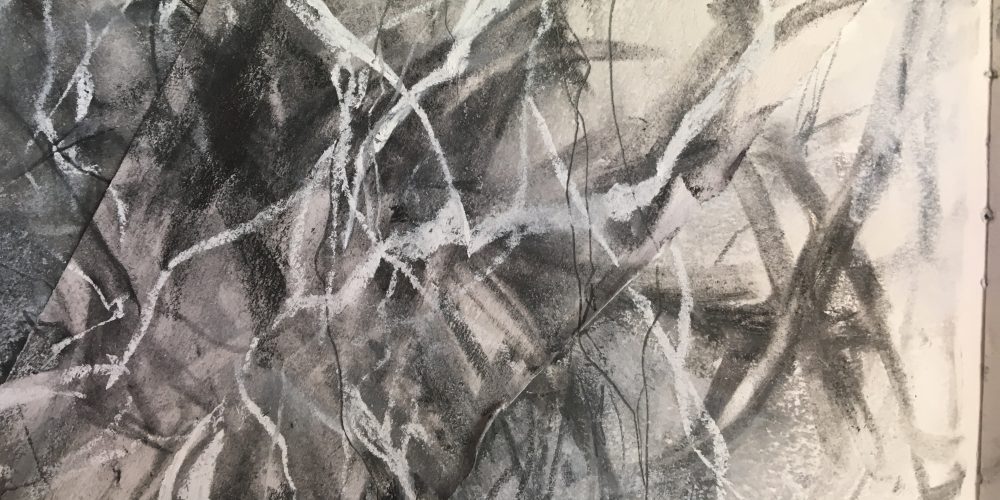‘Cezanne Portraits’
National Portrait Gallery
December 2017
The exhibition concentrates on one aspect of Cezanne’s work – his portraits – and features over 50 paintings which is about a quarter of the portraits he is known to have painted. During his lifetime he painted almost 1,000 paintings of which 160 are portraits. He painted 26 portraits of himself and 28 or 29 portraits of his wife, Hortense Fiquet. The exhibition explores the pictorial and thematic characteristics of his work – multiple versions of the same sitter, changes in his style and method and his developing ideas around identity and ageing.
Apart from the extraordinary opportunity of viewing the work of this important artist, I went to see this exhibition primarily to observe at close quarters his use of paint. Drawing is my primary medium and I am about to explore how to combine my love of drawing with investigations into paint. This exhibition did not disappoint on that score and I found myself utterly entranced with Cezanne’s masterly use of paint. His use of colour tones was breathtaking – every square inch of the canvas displayed innumerable tones of colour and it didn’t matter what the object was or how mundane a surface it was portraying. Every surface became a landscape of colour patches.
Some of his earliest work was done with a palette knife and the application was described as a ‘masonry-like application of paint’, particularly evident in the portraits of his uncle, Uncle Dominique.


Rather than displaying a violent and vehement manner, these paintings seem to display evidence of Cezanne’s emerging style of fascination with building up and modelling the surface with areas or patches of colour. In around 1877, the portraits begin to change as Cezanne begins a process of experimentation with shorter, more delicate brushstrokes – ‘the constructive brushstrokes’ – ‘hatching’.
I was interested in some work done around the 1880s. Cezanne had produced a group of Still Lifes at that time and his portraits began to reflect the same architectural approach as these. The heads of the sitters became oval shaped and there was a rhythm of interlocking arcs and ellipses. The effect was of approaching abstraction. “The Artist’s Son” 1881 and “Louis Guillaume” 1879.


It was also interesting to see the portraits of peasants done in the 1890s and to compare these to the previous exhibition I’d seen on the work of Soutine. These sitters were all workers in Aix, a place he had returned to from Paris and these portraits of its workers almost seen to epitomise his love of the province and its heritage. They have an aura of self assurance and quiet undramatic poses. It was as if Cezanne was expressing his love of the country through the human image – interesting concept! Unlike Soutine, I felt throughout that Cezanne was not totally engaged with his sitters – there seemed to me to be a space between painter and subject. The artist seemed to be on an exploratory path with colour, shapes , construction etc , rather than closely communicating with the character and life of the sitter. I noticed that the eyes were generally blackened shapes, rather than providing a glimpse of the person with light and expression.


I took particular note of Cezanne’s work in his later years and his final self portraits. For comparison, the first self portrait here was done when he was 36 and the second done in his sixties. There is a finality in this last portrait and a receding of the individual. They appear distant – the fire has gone out! Interest to study the first self portrait alongside the final one. The whole of a lifetime seems to be summed up in these – a lifetime of struggle and searching. The paintings of Vallier, the old gardener and Cezanne the ageing painter, appear to morph together in a series of paintings of the gardener. Even though physically Cezanne is appearing diminished, there seems to be no diminished energy in the way the paintings are done. The entry in the exhibition catalogue sums it up with the words, …”he died striving.
This was another important exhibition for me at this time. I could see Cezanne’s love of drawing throughout the work accompanied also with an emerging style in paint. This can be seen particularly in his wonderful paintings of the gardener, Vallier. I want to work with some experimentation in colour tones and find out how I can combine my love of working with my hands with paint.



